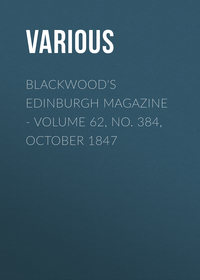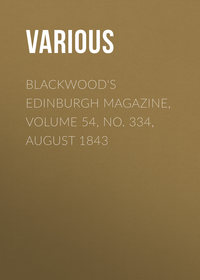 полная версия
полная версияBlackwood's Edinburgh Magazine, Volume 63, No. 389, March 1848
The principal articles in which the Hudson's Bay Company trade, are furs of all kinds, oil, dry and salt fish, feathers and quills. Of the furs, the most valuable is that of the black fox, which resembles the common English fox, but is much larger and jet black, except one or two white hairs along the back bone, and a white tuft at the end of the tail. This animal's skin is very valuable, worth twenty-five to thirty guineas in the English market, but the specimens are very scarce. Besides the black fox, there are silver foxes, cross foxes, red, white, and blue foxes, whose hides are variously esteemed. The black, silver, cross, and red, are often produced in the same litter, the mother being a red fox. Beaver was formerly the grand article of commerce, but Paris hats have killed the demand and saved the beavers, which now build and fatten in comparative security. The marten fur is the most profitable Hudson's Bay produces. All the animals above named, and a few others, are caught in steel and wooden traps by the natives. Deer and buffaloes are run down, shot, and snared. Mr Ballantyne rather startles us by the statement, that the Indians can send an arrow through a buffalo. "In the Saskatchewan, the chief food, both of white men and Indians, is buffalo meat, so that parties are constantly sent out to hunt the buffalo. They generally chase them on horseback, the country being mostly prairie land; and, when they get close enough, shoot them with guns. The Indians, however, shoot them oftener with the bow and arrow, as they prefer keeping their powder and shot for warfare. They are very expert with the bow, which is short and strong, and can easily send an arrow quite through a buffalo at twenty yards off." We almost suspect Mr Ballantyne of drawing a longer bow than his Indian friends. We do not understand him, however, to have himself seen any of these marvellous shots, (although he gives a spirited little drawing of a buffalo hunt,) and perhaps some of the wild fellows of the Saskatchewan brigade imposed upon his youthful credulity. These "brigades" are flotillas of boats, manned by Canadian and half-breed voyageurs, who take goods for barter to the interior, and bring back furs in exchange. The men of the Saskatchewan "come from the prairies and the Rocky Mountains, and are consequently brimful of stories of the buffalo hunt, attacks upon grizzly bears, and wild Indians; some of them interesting and true enough, but the most of them either tremendous exaggerations or altogether inventions of their own wild fancies." To return, however, to the buffaloes. Two calves were wanted alive, to be sent to England, and a party was ordered out to procure them.
"Upon meeting with a herd, they all set off full gallop in chase; away went the startled animals at a round trot, which soon increased to a gallop as the horsemen neared them, and a shot or two told they were coming within range. Soon the shots became more numerous, and here and there a black spot on the prairie told where a buffalo had fallen. No slackening of the pace occurred, however, as each hunter, upon killing an animal, merely threw down his cap or mitten to mark it as his own, and continued in pursuit of the herd, loading his gun as he galloped along. The buffalo-hunters are very expert at loading and firing quickly while going at full gallop. They carry two or three bullets in their mouths, which they spit into the muzzles of their guns after dropping in a little powder; and, instead of ramming it down with a rod, merely hit the but-end of the gun on the pummel of their saddles, and, in this way, fire a great many shots in quick succession. This, however, is a dangerous mode of shooting, as the ball sometimes sticks half-way down the barrel and bursts the gun, carrying away a finger, a joint, and occasionally a hand.
"In this way they soon killed as many buffaloes as they could carry in their carts, and one of the hunters set off in chase of a calf. In a short time he edged one away from the rest, and then, getting between it and the herd, ran straight against it with his horse and knocked it down. The frightened little animal jumped up and set off with redoubled speed, but another butt from the horse again sent it sprawling; again it rose and was again knocked down, and, in this way, was at last fairly tired out; when the hunter, jumping suddenly from his horse, threw a rope round its neck and drove it before him to the encampment, and soon after brought it to the fort. It was as wild as ever when I saw it at Norway House, and seemed to have as much distaste to its thraldom as the day it was taken."
Buffalo-meat, however, although abundant in the prairies, is scarce enough in other districts of the Hudson's Bay territory, and so, indeed, is game of all kinds; so that at certain times and seasons, both Indians and Company's servants are reduced to very short commons, and amongst the former starvation is by no means uncommon. The contrasts of diet are as striking as those of climate; the provender varying from the juicy buffalo hump and rich marrow-bone, to miserable dry fish and tripe-de-roche– a sort of moss or lichen growing on the rocks, which looks like dried-up sea-weed, and which only the extremity of hunger can render edible. From Peel's River, a post within the Arctic circle, a chief trader writes that all the fresh provisions he has seen during the winter, consisted of two squirrels and a crow. He and his companions had lived on dried meat, and were obliged to lock the gates to keep their scanty store from the Indians, who were literally eating each other outside the fort; for cannibalism is common enough amongst the Indians of that region, and Mr Ballantyne was acquainted with some old ladies who, on more than one occasion, had dined off their own children; whilst some, if report might be believed, had made a meal of their husbands. It is justice to the savages to say, that they do not eat human flesh by preference, but only when urged by necessity, and by the absence of all other viands. They will scrape the rocks bare of the tripe-de-roche– which, however, only retards starvation for a time, without preventing it, unless varied by more nutritious food – before cutting up a cousin. Now and then an aggravated case occurs, and one of these we find cited. In the middle of winter, Wisagun, a Cree Indian, removed his encampment on account of scarcity of game. With him went his wife, a son eight or nine years of age, two or three other children, and some relations – ten souls in all. Their change of quarters did not improve their condition. No game appeared, and they were reduced to eat their moccasins and skin coats, cooked by singeing them over the fire. This wretched resource expended, they were on the brink of starvation, when a herd of buffaloes was descried far away on the prairie. Guns were instantly loaded, and snow-shoes put on, and away went the men, leaving women and children in the tent. But the famished Indians soon grew tired; the weaker dropped behind; Wisagun, and his son Natappe, gave up the chase and returned to the encampment. Wisagun peeped through a chink of the tent, and saw his wife cutting up one of her own children, preparatory to cooking it. In a transport of rage, he rushed forward and stabbed her and a woman who assisted her in her horrible cookery; and then, fearing the wrath of the other Indians, he fled to the woods. When the hunters came in and found their relatives murdered, they were so much exhausted by their fruitless chase, that they could only sit down and gaze on the mutilated bodies. During the night, Wisagun and Natappe returned to the tent, murdered the whole party, and were met, some time afterwards, by another party of savages, in good condition; although, from scarcity of game, every body else was starving. They accounted for their well-fed appearance, by saying they had fallen in with a deer, previously to which, however, the rest of the family had died of hunger.
This horrible story was told to an Englishman in the Indian hall of a faraway post in Athabasca, by a party of Chipewyan Indians, come from their winter hunting-grounds to trade furs. They were the same men who had met the two Crees wandering in the plains after getting up their flesh by swallowing their family. The loathsome food had profited them, however, but a short while; for the Chipewyans had hardly told the tale, when "the hall door slowly opened, and Wisagun, gaunt and cadaverous, the very impersonation of famine, slunk into the room with Natappe, and seated himself in a corner near the fire. Mr C – soon learned the truth of the foregoing story from his own lips; but he excused his horrible deed by saying that most of his relations had died before he ate them."
Notwithstanding this sanguinary tale, the Crees, who inhabit the woody country surrounding Hudson's Bay, are the quietest and most inoffensive of all the Indian tribes trading with the Company. They never go to war, scalping is obsolete amongst them, and the celebrated war-dance a mere tradition. But their pacific habits and intercourse with Europeans seem as yet to have done little towards their civilisation. Some of their customs are of the most barbarous description. They have no religion, beyond the absurd incantations of the medicine tent; and the amount of Christianity English missionaries have of late years succeeded in introducing amongst them is exceedingly small. They drink to excess when they can get spirits; and formerly, when the Hudson's Bay Company, in order to contend successfully with other associations, thought it necessary to distribute rum and whisky to the natives, the use of the "fire-water" was carried to a fearful extent. They smoke tobacco, mingled with some other leaf; are excessively lazy, and great gamblers. Polygamists, they ill-treat their wives, compelling them to severe toil, whilst they themselves indulge in utter indolence, except when roused to the chase. On the march, when old men or women are unable to proceed, they are left behind in a small tent made of willows, in which are placed firewood, provisions, and a vessel of water. Here, when food and wood are consumed, the unfortunate, wretches perish. The habitual dwellings of the Crees are tents, of conical shape, made of deerskin, bark, or branches. The manner of construction is simple and rapid. Three poles are tied together at the top, their lower extremities spreading out in the form of a tripod; a number of other poles are piled around these at half-a-foot distance from each other; and thus a space is inclosed of fifteen to twenty feet in diameter. Over these poles are spread the skin-tent, or the rolls of birch-bark. The opening left for a doorway is covered with an old blanket, a deer-skin, or buffalo-robe; the floor is covered with a layer of small pine branches, a wood fire blazes in the middle; and in this slight habitation, which is far warmer and more comfortable than could be imagined, the Indian spends a few days or weeks, according as game is scarce or plentiful. His modes of securing and trapping the beasts of the plain and forest are curious, often as ingenious and effective as they are simple and inartificial. Mr Ballantyne initiates us in many of them in the course of a nocturnal cruise overland with Stemaw the Indian, which gives an excellent insight into trapper-life at Hudson's Bay. We start with the Cree from his tent, pitched in the neighbourhood of one of the Company's forts, at the foot of an immense tree, which stands in a little hollow where the willows and pines are luxuriant enough to afford shelter from the north wind. We have no difficulty in realising the scene, as graphically sketched by our young apprentice-clerk, who is frequently very happy in his scraps of description: – "A huge chasm, filled with fallen trees and mounds of snow, yawns on the left of the tent, and the ruddy sparks of fire which issue from a hole in its top throw this and the surrounding forest into deeper gloom. Suddenly the deerskin that covers the aperture of the wigwam is raised, and a bright stream of warm light gushes out, tipping the dark-green points of the opposite trees, and mingling strangely with the paler light of the moon; and Stemaw stands erect in front of his solitary home, to gaze a few moments at the sky and judge of the weather, as he intends to take a long walk before laying his head upon his capote for the night. He is in the usual costume of the Cree Indians: a large leathern coat, very much overlapped in front, and fastened round the waist with a scarlet belt, protects his body from the cold. A small ratskin cap covers his head, and his legs are eased in the ordinary blue cloth leggins. Large moccasins, with two or three pair of blanket-socks, clothe his feet, and fingerless mittens, made of deerskin, complete his costume. After a few minutes passed in contemplation of the heavens, the Indian prepares himself for the walk. First, he sticks a small axe in his belt, serving as a counterpoise to a large hunting-knife and fire-bag which depend from the other side. He then slips his feet through the lines of his snow-shoes, and throws the line of a small hand-sledge over his shoulder. The hand-sledge is a thin flat slip or plank of wood, from five to six feet long by one foot broad, and is turned up at one end. It is extremely light, and Indians invariably use it when visiting their traps, for the purpose of dragging home the animals or game they may have caught. Having attached this to his back, he stoops to receive his gun from his faithful squaw, who has been watching his operations through a hole in the tent, and throwing it on his shoulder strides off, without uttering a word, across the moonlit space in front of the tent, turns into a small narrow track that leads down the dark ravine, and disappears in the shades of the forest."
The snow-shoes above referred to, and which are in general use amongst both Indians and Europeans at Hudson's Bay, are as unlike shoes as any thing bearing the name well can be. A snow-shoe is formed of two thin pieces of light wood, tied at both ends, and spread out in the centre, thus making an oval frame filled up with network of deerskin threads. The frame is strengthened by cross-bars, and fastened loosely to the foot by a line across the toe. The length of the machine is from four to six feet; the width from thirteen to twenty inches. Being very light, they are no way cumbersome, and without them pedestrianism would be impossible for many months, of the year, on account of the depth of the snow, which falls through the meshes of these shoes, as the traveller raises his foot. That they are not fatiguing wear, is manifest from the fact that an Indian will walk twenty, thirty, and even forty miles a day upon them. Only in damp weather, the moist snow clogs the meshes, and the lines are apt to gall the foot. Apropos of this inconvenience, Mr Ballantyne avails himself of the traveller's privilege, and favours us with a remarkable anecdote, told him by a Highland friend of his, Mr B – , chief of the Company's post at Tadousac.
"On one occasion, he was sent off upon a long journey over the snow where the country was so mountainous, that snow-shoe walking was rendered exceedingly painful by the feet slipping forward against the front bar of the shoe when descending the hills. After he had accomplished a good part of his journey, two large blisters rose under the nails of his great toes; and soon the nails themselves came off. Still he must go on, or die in the woods; so he was obliged to tie the nails on his toes each morning before starting, for the purpose of protecting the tender parts beneath; and every evening he wrapped them up carefully in a piece of rag, and put them into his waistcoat pocket, —being afraid of losing them if he kept them on all night." This Mr B – had had a long and eventful career in North America, and was rich in 'yarns,' more or less credible, with which he regaled Mr Ballantyne during a journey they made together. A deep scar on his nose was the memorial of a narrow escape he had made when dwelling at a solitary fort west of the Rocky Mountains. He had bought a fine horse of an Indian, one of the Blackfeet, a wild and warlike tribe, notorious as horse-stealers. The animal had been but a short time in his possession, when it was stolen. This was a very ordinary event, and was soon forgotten. Spring came, and a party of Indians arrived with a load of furs for barter. They were admitted one by one into the fort, their arms taken from them and locked up – a customary and necessary precaution, as they used to buy spirits, get drunk and quarrel, but without weapons they could do each other little harm. When about a dozen had entered, the gate was shut, and then Mr B – beheld, to his surprise, the horse he had lost the previous year. He asked to whom it belonged, and the Indian who had sold it him unblushingly stood forward. "Mr B – (an exceedingly quiet, good-natured man, but like many men of his stamp, very passionate when roused) no sooner witnessed the fellow's audacity than he seized a gun from one of his men, and shot the horse. The Indian instantly sprang upon him; but being a less powerful man than Mr B – , and withal unaccustomed to use his fists, he was soon overcome, and pommelled out of the fort. Not content with this, Mr B – followed him down to the Indian camp, pommelling him all the way. The instant, however, that the Indian found himself surrounded by his own friends, he faced about, and with a dozen warriors attacked Mr B – , and threw him on the ground, where they kicked and bruised him severely; whilst several boys of the tribe hovered around with bows and arrows, waiting a favourable opportunity to shoot him. Suddenly a savage came forward with a large stone in his hand, and, standing over his fallen enemy, raised it high in the air and dashed it down upon his face. Mr B – , when telling me the story, said that he had just time, upon seeing the stone in the act of falling, to commend his spirit to God, ere he was rendered insensible. The merciful God, to whom he thus looked for help at the eleventh hour, did not desert him. Several men belonging to the fort, seeing the turn things took, hastily armed themselves, and, hurrying out to the rescue, arrived just at the critical moment when the stone was dashed in his face. Though too late to prevent this, they were in time to prevent a repetition of the blow; and, after a short scuffle with the Indians, without any bloodshed, they succeeded in carrying their master up to the fort, where he soon recovered. The deep cut made by the stone on the bridge of his nose, left an indelible scar."
To return to Stemaw the trapper, whom we left striding along with confident step, as though the high road lay before him, although no track or trail, discernible by European eye, is there to guide his footsteps. After a walk of two miles, a faint sound a-head brings him to a dead halt. He listens, and a noise like the rattling of a chain is heard from a dark, wild hollow in his front. "Another moment, and the rattle is again distinctly heard; a slight smile of satisfaction crosses Stemaw's dark visage; for one of his traps was set in that place, and he knows that something is caught. Quickly descending the slope, he enters the bushes whence the sound proceeds, and pauses when within a yard or two of his trap to peer through the gloom. A cloud passes off the moon, and a faint ray reveals, it may be, a beautiful black fox caught in the snare. A slight blow on the snout from Stemaw's axe-handle kills the unfortunate animal; in ten minutes more it is tied to his sledge, the trap is reset and again covered over with snow, so that it is almost impossible to tell that any thing is there; and the Indian pursues his way." And here we have a drawing of Reynard the Fox, a fine specimen of his kind, black as coal, with a white tuft to his tail, looking anxiously about him, his fore-paw fast in the jaws of a trap, with which a heavy log, fastened by a chain, prevents his making off. In the distance, the Indian, gun on shoulder, his snow-shoes, which look like small boats, upon his feet – strides forward, eager to secure his valuable prize. We give Mr Ballantyne all credit for the unpretending but useful wood-cuts scattered through his book, which serve to explain things whose form or nature would otherwise be but imperfectly understood. They are an honest and legitimate style of illustration, exactly corresponding to the requirements of a work of this kind.
The steel trap in which the fox is caught resembles a common English rat-trap, less the teeth, and is so set, that the jaws, when spread out flat, are exactly on a level with the snow. The chain and weight are hidden, a little snow is swept over the trap, and nothing is visible but the bait – usually chips of frozen partridge, rabbit, or fish, which are scattered all around the snare. Foxes, beavers, wolves, lynx, and other animals, are thus taken, sometimes by a fore-leg, sometimes by a hind one, or by two at once, and occasionally by the nose. By two legs is the preferable way – for the trapper, that is to say – for then escape is impossible. "When foxes are caught by one leg, they often eat it off close to the trap, and escape on the other three. I have frequently seen this happen; and I once saw a fox caught which had evidently escaped in this way, as one of its legs was gone, and the stump healed up and covered again with hair. When caught by the nose, they are almost sure to escape, unless taken out of the trap very soon after capture, as their snouts are so sharp and wedgelike, that they can pull them from between the jaws of the trap with the greatest ease." We are tempted to doubt the ease, or at any rate the pleasure, of such an operation, and to compassionate the unfortunate quadrupeds, whose only chance of escape from being knocked on the head lies in biting off their own feet, or scraping the skin off their jaws between those of a trap. The poor brutes have no chance of a fair fight, or even of a few yards' law and a run for their lives. Their hungry stomachs and keen olfactories touchingly appealed to by the scraps of frozen game, they eat their way to the trap, and finally put their foot in it. The trapper's trade is a sneaking sort of business; and one cannot but understand the feeling of self-humiliation of Cooper's Natty Bumpo, upon finding himself reduced from the rifle to the snare – from the stand-up fight in the forest to the stealthy prowl and treacherous trap. And hence, doubtless, do we find the occupation far more frequently followed by Indians and half-breeds than by white men – at least at Hudson's Bay. Nevertheless Mr Ballantyne, whilst enjoying dignified solitude in the remote station of Seven Islands, his French-Canadian servant and his Newfoundland dog Humbug for sole companions, received the visit of a trapper, who was not only white, but a gentleman to boot. This individual, who was dressed in aboriginal style, had been in the employ of a fur company, had married an Indian girl, and taken to trapping. He was a good-natured man, we are told, and had been well educated – talked philosophy, and put his new acquaintance up to the fact, that what he for some time had taken for a bank of sea-weed, was a shoal of kipling, close inshore. He stopped a week at the station, living on salt pork and flour-and-water pancakes, and telling his adventures to his gratified host, to whom, in his lonely condition, far worse society would have been highly acceptable.
The trapper's occupation is not always unattended with danger. So long as he has only foxes and such small gear to deal with, whom a tap on the snout finishes, it is mere child's play, barring the fatigue of long walks and heavy loads; but now and then he finds an ugly customer in one of his traps, and encounters some risk before securing him. This we shall see exemplified, if we follow Stemaw to two traps, which he set in the morning close to each other, for the purpose of catching one of the formidable coast-wolves. "These animals are so sagacious, that they will scrape all round a trap, let it be ever so well set, and, after eating all the bait, walk away unhurt. Indians consequently endeavour in every possible way to catch them, and, amongst others, by setting two traps close together, so that, whilst the wolf scrapes at one, he may perhaps put his foot in the other. It is in this way Stemaw's traps are set; and he now advances cautiously towards them, his gun in the hollow of his left arm. Slowly he advances, peering through the bushes; but nothing is visible. Suddenly a branch crashes under his snow-shoe, and, with a savage growl, a large wolf bounds towards him, landing almost at his feet. A single glance, however, shows the Indian that both traps are on his legs, and that the chains prevent his further advance. He places his gun against a tree, draws his axe, and advances to kill the animal. It is an undertaking, however, of some difficulty. The fierce brute, which is larger than a Newfoundland dog, strains every nerve and sinew to break its chains; whilst its eyes glisten in the uncertain light, and foam curls from its blood-red mouth. Now it retreats as the Indian advances, grinning horribly as it goes; and anon, as the chains check its further retreat, it springs with fearful growl towards Stemaw, who slightly wounds it with his axe, as he jumps backward just in time to save himself from the infuriated animal, which catches in its fangs the flap of his leggin, and tears it from his limb. Again Stemaw advances and the wolf retreats, and again springs upon him, but without success. At last, as the wolf glances for a moment to one side – apparently to see if there is no way of escape – quick as lightning the axe flashes in the air, and descends with stunning violence on its head; another blow follows, and in five minutes more the animal is fastened to the sledge."









